History of the Appearance and Distribution of the Potato
The potato appeared on earth more than 12,000 years ago. Some scientists dispute its 14,000-year existence. The first wild potato grew in the highlands of South America.
For Native Americans, the potato was a very valuable food item. It was eaten, exchanged for important and valuable things, spiritualized, and worshipped. The Incas used potatoes for divination and even timing. They took as a unit the cooking time of medium-sized tubers. It was about one hour.
The Europeans were the first to learn about the potato. The history of the potato’s appearance in Europe dates back to the great Spanish conquests of the 16th century AD. On voyages to America, Europeans brought with them overseas curiosities. At that time, the overseas vegetable was not immediately understood. In all European countries the spread of the potato was slow. Sometimes they did not know what to do with this plant. And they considered it poisonous.
In France at first it was grown because of its beautiful flowers. In Germany, in order to get people interested in growing potatoes, a decree was issued “to cut off the noses and ears” of those who did not want to grow them. In England, gold medals were promised for growing potatoes.
The first appearance of the potato in Russia dates back to the late 17th century. While in the Netherlands Peter I was interested in the potato. At the first time this vegetable was considered exotic. At balls and banquets in the palace it was served as a rare and dainty dish. It was sprinkled with sugar, not salt.
The potato was poorly disseminated because of people’s ignorance of its cultivation techniques and peculiarities. Two centuries later, the potato has emerged as a major edible crop. Throughout the history of potato growing, many new high-yield varieties with different taste and nutritional qualities, resistant to various diseases have been bred.
Today, the potato is an essential staple food for many nations of the world. It is grown in all countries with temperate climates. Thousands of different dishes have potatoes as main ingredient. Today the leader in potato growing is China. Potatoes are used to make: french fries, chips, croquettes.
Useful Properties of Potatoes
Only potato tubers are used as food. The upper part of the shrub (the stems, leaves, flowers and fruits) contain the alkaloid solanine. It causes poisoning of the body.
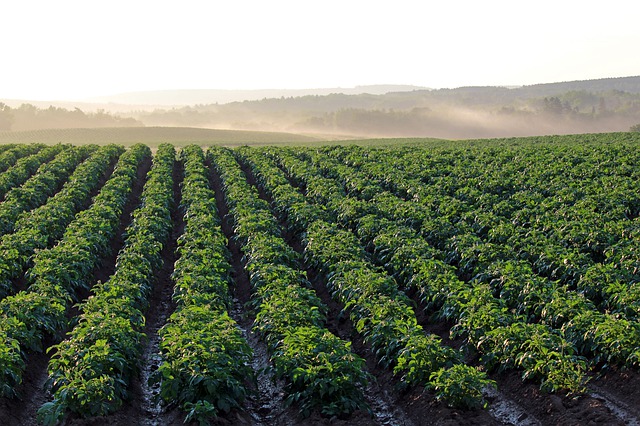
Potatoes contain:
- a large amount of starch;
- a balanced set of amino acids;
- vitamins B, C, H and PP;
- folic acid;
- minerals: potassium, calcium, magnesium, zinc, selenium, copper and manganese, iron, chlorine and sulfur, iodine, chromium, fluorine, molybdenum, boron and vanadium, tin and titanium, silicon, cobalt, nickel and aluminum, phosphorous and sodium.
Potatoes are high in potassium. It helps reduce blood cholesterol levels and prevents the appearance of cholesterol plaques on the walls of blood vessels. Fiber – does not irritate the stomach walls, so boiled potatoes are included in the dietary treatment menu.
Potatoes are useful:
- in diseases associated with metabolic disorders-product in the body works as an alkali, neutralizes the action of acids;
- stimulates brain activity;
- relieves stress;
- strengthens the immune system;
- protects against age spots and heals bruises;
- normalizes the functioning of the kidneys.

Potatoes are often included in the menu of diets and unloading days. There is a potato diet, potassium diet, starvation diet – these principles of nutrition will help to lose weight or maintain weight.
- Most useful are potatoes cooked in their peel – boiled in jacket or baked. It retains all the vitamins and minerals.
- Crushed hot potatoes – an excellent compress for coughs, and for inflammatory skin diseases.
- Grated raw potatoes are applied to burns, fungal and rusty lesions. It has a soothing and healing effect.
Because of the high caloric value and high starch content, potatoes should not be consumed by people prone to obesity and suffering from diabetes.
Benefits of purple (blue) potatoes:
- purple potato dishes lower blood pressure levels;
- tubers contain large amounts of antioxidants, slow down the aging process;
- beneficial properties of vitamins C, E and carotenoids (natural organic pigments) – strengthen the immune system, blood vessel walls, improve vision, prevention of atherosclerosis.
- but if you have low blood pressure this potato can not be used.
Sweet potatoes have a yam:
- caloric value is lower than that of ordinary potatoes – 61 kcal/100 g;
- tubers contain beta-carotene, vitamins A and C, calcium, iron, phosphorus;
- when consuming these potatoes:
- normal water and electrolyte balance in cells is maintained;
- bone tissue strengthens;
- excrete radionuclides and heavy metals;
- used in diet diets to reduce weight and maintain a good figure – fiber quickly saturates the body and does not deposit in problem areas;
- easily digestible;
- has antibacterial, antifungal and immunomodulatory qualities;
- protects against heart and gastrointestinal problems.

The benefits and harms of potatoes
Benefits of raw potatoes
Up to 70% of the useful composition is washed out and decomposed during cooking. Consuming the root vegetable in its raw form is fully preserved vitamins and minerals. In fresh hard tubers with a yellow rind – a large content of carotene. The taste can be nutty or sweet, juicy or dry, most importantly, that there was no bitterness.
The benefits of potato juice
Potato juice is used for medicinal purposes. It helps against fatigue and nervousness, swelling, constipation, migraines, joint inflammation, hypertension, hair loss, acne and early aging skin. The drink should be taken immediately or within 10 minutes.
The harm of fried potatoes
Despite the pleasant taste and nutritiousness of the dish, a large load on the digestive tract is created. The high caloric content leads to rapid weight gain. Roasted potatoes lose water in the cooking process and become saturated with fats. When fried for a long time in a large amount of fat in the product the carcinogen acrylamide is formed.
The harm of French fries
The only benefits of French fries are their ability to effectively and quickly satisfy your hunger and their method of cleaning, which preserves the top layer that contains the most nutrients. French fries contain trans fats. They affect the development of cholesterol plaques, suppress immunity, and can provoke cancer. Excess salt disrupts kidney function, negatively affects the cardiovascular system.
The benefits of boiled potatoes
The benefits of boiled potatoes as a source of natural vitamin and mineral complex. It contains choline – it neutralizes a strong concentration of fatty acids.
The benefits of potato decoction
Potato decoction is often used in folk medicine. This remedy treats arthritis and polyarthritis, normalizes blood pressure. The benefits of decoction of potatoes in the treatment of colds, runny nose, cough and as a home inhalation. Taking decoction internally – to cope with sleep disorders, fully relax the muscles.
The benefits of jacket potatoes
Potatoes in jacket is the healthiest dish of all the options for cooking the root vegetable. The rind contains the most useful substances: magnesium, potassium and a significant portion of vitamins. It is right to eat cooked potatoes in the jacket young potatoes, without blemishes, carefully washed.
From the peel of the potato is made an extract and sold in the form of dietary supplements. Tea or decoction from potato peels is a means of detoxifying the body, supports electrolyte balance, heals wounds. Harm can be caused by solanine – collected in the green areas.
The benefits of baked potatoes
Tasty and healthy baked potatoes, do not contain harmful fats when cooked in foil. In terms of calories, only 99 kcal.
Calories and nutritive value of potatoes
Calories per 100g – 76 kcal, protein – 2 g, fat – 0.4 g, carbohydrates – 16.1 g
| Preparation method | Energy value, kcal | Water, g/100 g | Carbohydrates, g/100 g | Fats, g/100 g | Protein, g/100 g |
| chips | 551 | 2,3 | 49,7 | 37,9 | 5,8 |
| French fries | 264 | 45,9 | 36,7 | 12,1 | 4,1 |
| fried | 157 | 64,3 | 27,3 | 4,8 | 2,8 |
| mashed potatoes | 106 | 78,4 | 15,2 | 4,7 | 1,8 |
| baked | 99 | 73,3 | 22,9 | 0,1 | 2,5 |
| raw | 80 | 78,0 | 18,5 | 0,1 | 2,1 |
| boiled | 72 | 81,4 | 16,8 | 0,1 | 1,7 |
| in jacket | 76 | 79,8 | 18,5 | 0,1 | 2,1 |
Types and Varieties of Potatoes
There are thousands of potato varieties. All of its varieties are divided into groups. They are differentiated in three ways: tuber color, age and flesh density. The shorter the maturity of tubers, the more their taste is impaired. This is due to the loss of starch in the potatoes.
To determine whether the potatoes after cooking will be crumbly or hard whole, you need to pay attention to the variety and color of the skin.
Potato variety and the result of cooking:
- Red varieties of potatoes do not become crumbly after cooking, but retain their shape;
- the white varieties are boiled and are ideal for preparing mashed potatoes;
- Yellow varieties retain their shape after cooking, but become soft on the inside.

There are rare varieties which are deep black, blue or purple. Their taste varies:
- The brighter the color of the potato rind, the more beneficial components it contains;
- The richer the color, the less the potatoes digest.
Potato varieties vary in terms of their yields and rate of ripening.
Early
Early potato varieties grow quickly and have a short development time. They take 60-70 days to fully ripen. Early potatoes do not store well and are not adapted to retain moisture for long periods.
Mid-early
Store better. The full growing period is 60-80 days.
Medium-ripening
The most common species. The growth period is 80-100 days. Have good taste qualities.
Medium-late and late varieties
The most unpretentious varieties. Well kept in winter time. Growth period is from 100 to 120 days.
Varieties can be used for commercial purposes:
- Table varieties. Used as food. They are soft, crumbly, do not darken, have low starch and high vitamin C content.
- Industrial. Varieties are in accordance with the state standard. Supplied in large quantities for fresh consumption.
- Technical. Varieties used for the preparation of alcohol and starch products.
- Fodder. Large tubers, with a high percentage of starch and protein.
- Universal. Contain a medium starch content and are suitable for food and produce.
Colored potatoes
Is a new type of potato. It has a bright coloring. The properties of colored potatoes do not differ from the ordinary varieties. It contains more vitamins, antioxidants and has an increased level of insulin.
The useful properties of multicolored potatoes depend on the saturation of their color. The brighter the color of the vegetable, the more useful and nutritious it will be.
Blue potato
This variety is of French origin. Characterized by a bright blue color of the flesh and almost black rind. Nutritious, has a high density. Keeps well.
Black potatoes
The variety has a completely black rind, the flesh is a dark purple shade. Does not taste any different from ordinary potatoes. Contains a lot of starch. When boiled they become crumbly.
Purple potato
Violet is a lusciously purple variety. It is rich in vitamins and retains its rich color when cooked. Because of their thick skin, they store well. They keep all their nutritional and healthy properties.
Red potatoes
A very tasty variety. Has a red skin and light pink flesh inside with a delicate taste.
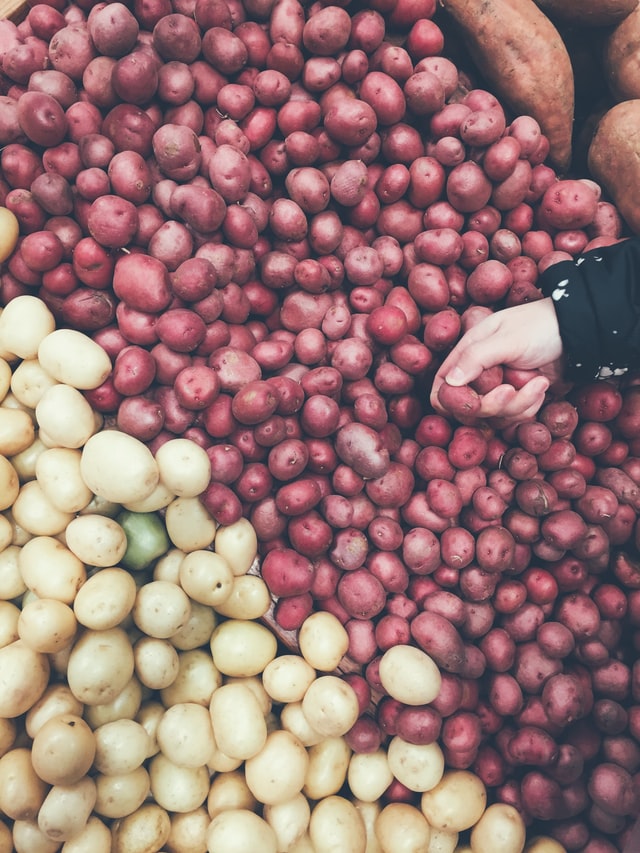
How to Choose a Potato
Good potatoes have:
- A firm surface with no sprouts or green spots;
- The presence of shallow eyelets;
- The skin is smooth and unscratched.
The choice of potatoes for different dishes:
- for salads, small potatoes of any dark variety are suitable (will retain structure after boiling and will cook quickly);
- for potatoes “in the jacket” – dark and yellow varieties of small size are suitable (retain their shape and boil well);
- the pink potato varieties are good for frying;
- for mashed potatoes – large white varieties (no lumps in the mashed potatoes).
The healthiest potatoes are those cooked “in the jacket”. For preparing salads, it is better to boil them in their peel. After boiling, by scraping away the skin.
How do you Know when a Potato is Bad?
- The presence of a green color on the rind (usually spots) indicates an increased content of alkaloids;
- brown spots on the rind, small holes and deep grooves on the rind indicate the influence of fungal microorganisms and bugs;
- If the surface of the potatoes is wet;
- potatoes with sprouts – they contain alkaloids;
- if you try to pierce the skin of a potato with your fingernail, moisture oozes from it – this is the first sign of nitrates, which are bad for your health;
- if you squeeze the tuber – if the potato is soft or wrinkled, it is spoiled;
- If the potatoes have an unpleasant smell.
Variants of Cutting Potatoes
The appearance and taste of the dish depends on the shape of the cut of the potato: if the slices are identical – they are boiled or fried evenly.
Preliminary preparation
- Before slicing, wash the tubers well.
- If you will peel potatoes – just wash the skin with your hands, so that the damage and eyes are clearly visible.
- For cooking tubers in the peel (boiling in the jacket, baking peeling) – wash particularly carefully: rub with a brush under water. Damaged tubers do not use. Potatoes of such preparation (boiled or stewed in a rustic way) – you can eat them with the skin. After processing with a brush, the skin becomes thin.
- If you cook potatoes without peel, after washing peel, cut out the eyes and the damaged places. Dip in cold water so that the flesh does not darken.
- First slice all the peeled potatoes, then transfer them to a container for cooking.
- If you slice one potato at a time and put it into a hot pan or pot with boiling water, the dish will cook unevenly.
Cutting potatoes can be simple or shaped. The simple slicing method is easy to do with any knife, without first “sharpening” the tuber. Types of simple slicing: circles, slices, bars, cubes, straws, slices, shavings.
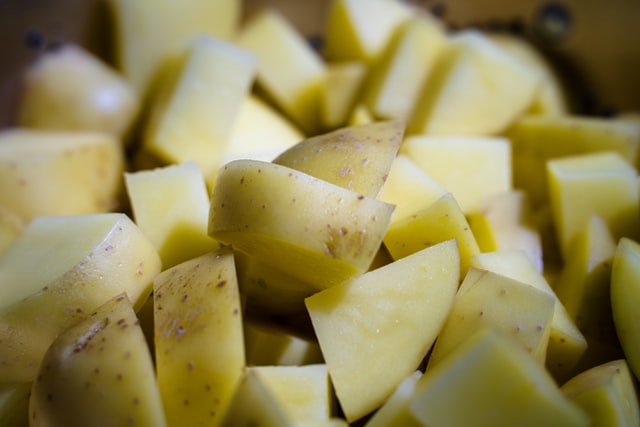
Сircles
- Cut peeled and washed potatoes into circles.
- The thickness is 1-1.5 cm.
- This cutting method is called paysanne.
- Slices 1.5-2 cm thick, use for soups, stews, baked potato wedges.
- Use 0.7-1 cm rounds in deep fryer.
- To fry potatoes in the usual way – cut the tubers into 2-3 mm thick circles
- For making chips – 1-2 mm thick. Cut small and medium-sized tubers in this way. Large potatoes are difficult to cut into thin circles with an ordinary knife. To make homemade potato chips, shred the potatoes with a shredder.
Slices
- Cut potato circles into 2 or 4 parts – you will get slices.
- Cut the tuber lengthwise into 2 pieces. If the potatoes are large, cut each half lengthwise into two pieces as well. Slice these slices crosswise. While you cut one half of the tuber, dip the other half in water.
- Slices 1-2 cm thick are good for cooking soups, baking.
- For frying, cut potatoes into slices 2-3 mm thick.
Pieces
- For slicing, medium-sized tubers are good, less often small tubers.
- Cut the potato into 4 parts (as for slices).
- Cut each quarter in half to make slices.
- This form of slicing is good for baking with stuffed duck apples, stewing potatoes with meat, making potato wedges, and stir-frying.
Bars
- Choose tubers about the same size.
- Wash and peel them.
- Cut a piece off each side of the tuber to make a rectangular parallelepiped.
- Cut it into strips.
- Stack the plates one on top of the other and cut them into bars.
- The size of the bar is a square with a side of 6-7 mm.
- These slices are called batonnet. These batonnet slices are deep-fried.
Cube slices are suitable for soups and frying.
Straws
Straws are very thin slices, only small.
Types of straws:
- julienne – bars 2 mm thick and 2.5 cm long;
- pai – length 4-5 cm.
Straws are fried in a deep fryer for french fries, use for Korean salads.
To slice the tuber into straws – you need a very sharp knife.

Cubes
- For cubes – cut the tuber into slices.
- And cut the stack of slices crosswise.
Dice raw tubers for soups, cooked tubers for salads, appetizers.
Types of cubes:
- brunoise (brunoise) – 1-2 mm facet;
- jardinière – 3-4 mm;
- macedonian (macédonienne) – 5 mm;
- paisan – parallelepipeds with a base of 1 × 1 cm and a height of 0.3-0.4 cm.
Chips
- Potato shavings are long thin ribbons 1-2 cm wide.
- Cut them with a regular knife or a special device.
- Fry the potato strips in a deep fryer.
Ways to “trim” whole tubers
For beauty and the same size of whole potatoes in the finished dish – give them different shapes.
Barrels
- Cut off the top and bottom of the potato. Trim the sides of the tuber to form a keg.
- Braise the kegs as a whole or remove the middle, stuff and bake. Barrel-shaped tubers are sturdy – you can place compactly in a baking dish.
Garlic barrels
- For the garlic – cut the keg into slices.
- From the sharp edge of each slice, cut off a bit of pulp.
“Harmonicas”
- On the tubers, make deep transverse incisions 3-4 mm apart.
- Insert pieces of lard or cheese into the cuts and bake.
“Pears”
Cut the tuber, giving it a pear shape. Such potatoes are suitable for baking.
“Booties”
- Wash and peel medium-sized tubers.
- Make a transverse incision on the tuber.
- Use a knife and spoon to form a “lapot.” Make shallow crosswise and longitudinal incisions on the toe.
- Stuff the lapti, brush with butter and bake in the oven.
“Mushrooms”
- Wash a tuber with a brush, make a circular transverse incision.
- Leave one half of the potato with its skin (this is the “hat”), cut the other half, forming a “foot”.
- Brush the mushrooms with butter and spices and bake.
Shaped cutting of potatoes
Special tools are needed for shaped slicing.
Wavy potato chips
- Peel the tuber and slice it as well as into circles.
- Use a special knife with a wavy blade.
Balls
- For potato balls, you need a special spoon. Insert it into the tuber and twist the stalk around its axis.
- You will get neat identical balls of small size.
- Bake or deep fry them.
Spirals
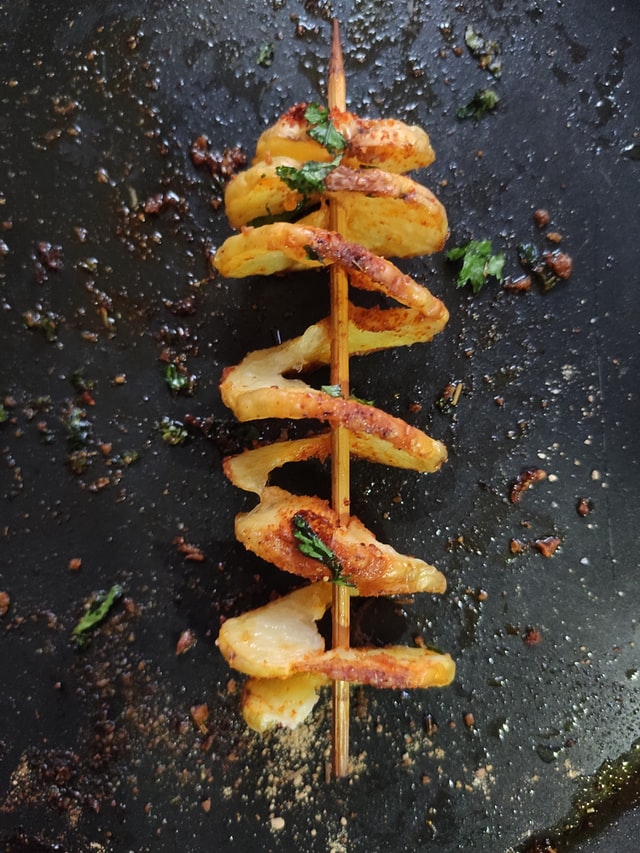
- Insert a metal skewer into the raw tuber.
- Screw a tool with a sharp blade onto it.
- The knife will cut the potato – you will get one long ribbon 1 – 2 mm thick, twisted into a spiral.
- Do not remove the spirals from the skewers. Immediately fry in a deep fryer (like chips). They look very impressive.
Slicing for country-style potatoes
So that when baked, the largest area of the slices will be covered with a golden crust:
- Cut the tuber lengthwise.
- Cut each half at a 30° angle.
How to Store Potatoes?

For long storage, choose potatoes of medium size, healthy, fully matured and dried, without shoots, cleaned of dirt and soil.
For short storage, leave slightly damaged, pest-infested vegetables. These should be used first. Damaged or infested tubers are not suitable for long-term storage.
Store potatoes at room temperature
Potatoes can be stored at room temperature for only a short time. The place for this should be a cool, dry place that does not get any sunlight. Put the potatoes in wooden or plastic containers. A temperature of +2°C (35.6°F) to +5°C (41°F) is suitable .
The shelf life of potatoes at room temperature depends on the storage conditions. On average, it varies from 2 weeks to 3 months.
Boiled potatoes at room temperature do not spoil even in 24 hours. They should be taken for hiking and travel. Must be well packed and not mashed.
Do not store peeled potatoes at room temperature for more than 1 day.
Storing potatoes in the refrigerator
There are negatives to storing potatoes in the refrigerator:
- At low temperatures, the potato starch turns into sugars – this negatively affects the taste and quality of the potatoes. The tubers become sweet.
- In the refrigerator, potatoes dry out and sprout.
The shelf life of potatoes in the refrigerator is 7 to 20 days.
Boiled potatoes will keep in the fridge for 7 to 10 days. Put them in a tightly covered container and put some paper towels on the bottom. Change the napkins every day or once every 2 days.
Cooked jacket potatoes are not very different in shelf life from baked or boiled unpeeled potatoes – at most jacket potatoes will keep a couple of days longer than plain boiled potatoes.
In the refrigerator, peeled and soaked potatoes will not last more than 4 days. Later, the starch will be released intensively, the water will turn cloudy, and the potatoes themselves will be covered with mucus.
Storing potatoes in the freezer, freezing
Do not freeze raw potatoes. They will have an unpleasantly sweet taste when defrosted. To freeze potatoes, you need to boil them in water or steam them beforehand.
Frozen potatoes should be stored at -18°C (-0.4°F).
The shelf life of potatoes in the freezer is 6-9 months.
Properly prepare the potatoes for freezing: wash them well from dirt, peel them and put them in cold water for a while.
Methods of freezing potatoes:
- freezing whole potatoes
For this freezing, it is better to use small potatoes.
- Take two containers – one with boiling water, the other with cold water and ice.
- First dip the potatoes in boiling water for 3-4 minutes, then in ice water for 2-3 minutes.
- Until completely dry, spread the potatoes out on paper towels.
- Place the dried tubers in airtight bags and send them to the freezer for storage.
To use potatoes – they do not need to be completely thawed – immediately subject them to heat treatment.
- freezing potato slices
The principle of preparing the potatoes is the same as for whole frozen potatoes. Only in this case you cut the potatoes into small slices, slices, cubes or slices.
Ways to Prepare Potatoes
Potatoes are very tasty and healthy vegetable. Potatoes are used in many countries around the world. Potatoes are used for cooking first and second courses, baked, stewed, fried, added as a filling to muffins.
Boiling potatoes with water
- Wash and peel potatoes;
- Pour boiling salted water over potatoes;
- Bring to boil, boil under a closed lid until tender.
- Pierce the potatoes – determine their readiness by using a cooking needle, a regular knife or a fork.
- Drain the liquid, dry the potatoes for 2-3 minutes and season.
Steaming potatoes
- Put potatoes in a steamer in boiling water and salt;
- Under a tightly closed lid, boil the potatoes until tender;
- When ready, drain the water and cover the potatoes with a thick cloth for 4-5 minutes – they will absorb excess moisture;
- Season the potatoes.
Dress the potatoes – pour butter or sour cream, or serve them separately, sprinkle with chopped herbs. Serve boiled potatoes with fried onions, fried mushrooms, sauces: red with onions, gherkins, tomato, sour cream, sour cream with onions, mushroom, etc.
Make mashed potatoes from boiled potatoes.
Frying potatoes the basic way
- You can fry potatoes from raw and pre-boiled potatoes.
- Cut the raw potatoes into bars, slices, cubes or slices;
- Rinse in cold water – the slices will not stick or stick to the frying surface;
- Pat dry. On a baking pan with heated fat (a layer of 4-5 cm) – fry until crusted;
- Salt and fry until soft.
You can fry potatoes boiled in their peel. Just peel it.
Fry potatoes in melted butter, sprinkle with chopped greens, additionally in a salad bowl serve fresh, pickled, marinated cucumbers, tomatoes, salad of fresh cabbage or sauerkraut.
Deep fry potatoes
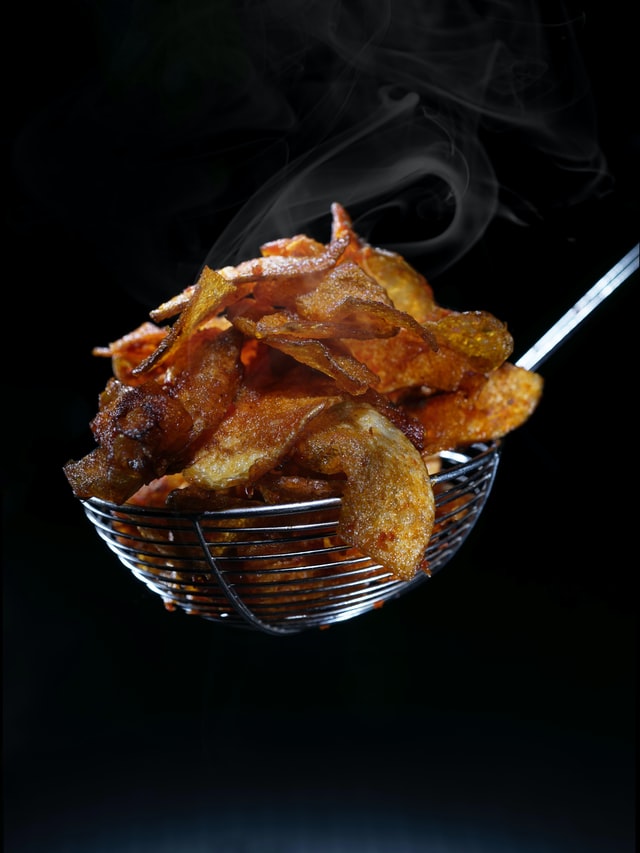
- Slice the prepared potatoes in any way you like;
- Wash and dry the potatoes well;
- Put them in a frying pan heated to 170-180°C;
- Fry until crispy and soft (8-10 minutes);
- Toss fried potatoes in a colander to drain fat and sprinkle with salt.
Use deep-fried potatoes as a stand-alone dish and as a side dish
Grilling potatoes
- Prepared tubers of potatoes cut coarsely – slices, circles, barrels;
- Drizzle with oil;
- Grill until the potatoes are crispy and streaky.
You can also grill potatoes al dente – not fully cooked. This adds an unusual touch to the dish.
Use the grilled potatoes as a main dish. Serve it with grilled bacon, cheese, green onions, and sour cream. Also use it as a complex side dish, make salads, hot appetizers.
Baked potatoes

- Cut the prepared potatoes in half;
- Sprinkle with oil and place them on a baking tray;
- At 220°C for about 20 minutes until soft.
Use baked potatoes as a main dish with butter, greens and as a side dish to roast meat and fish.
Potatoes can be baked whole in foil. Oil the foil, add spices, garlic, wrap the potatoes and place on a baking tray. Bake for about 15 minutes. Unroll the foil and bake the potatoes for another 5-7 minutes to form a ruddy, dried crust.
Stewed potatoes
- Cut peeled potatoes into slices, slices, or cubes;
- Before stewing, lightly roast potatoes, add bay leaf and salt and pepper to taste;
- Braise potatoes with milk sauce, sour cream sauce, or other sauce;
- Add liquid – broth or water 10-15% of the weight of the vegetables.
You can sprinkle the braised potatoes with chopped parsley or dill greens. Serve as an independent dish with mushrooms, onions and carrots, garlic, or as a side dish to meat dishes.
Potato Recipes Ideas
1. Jamie Oliver’s potato salad with bacon
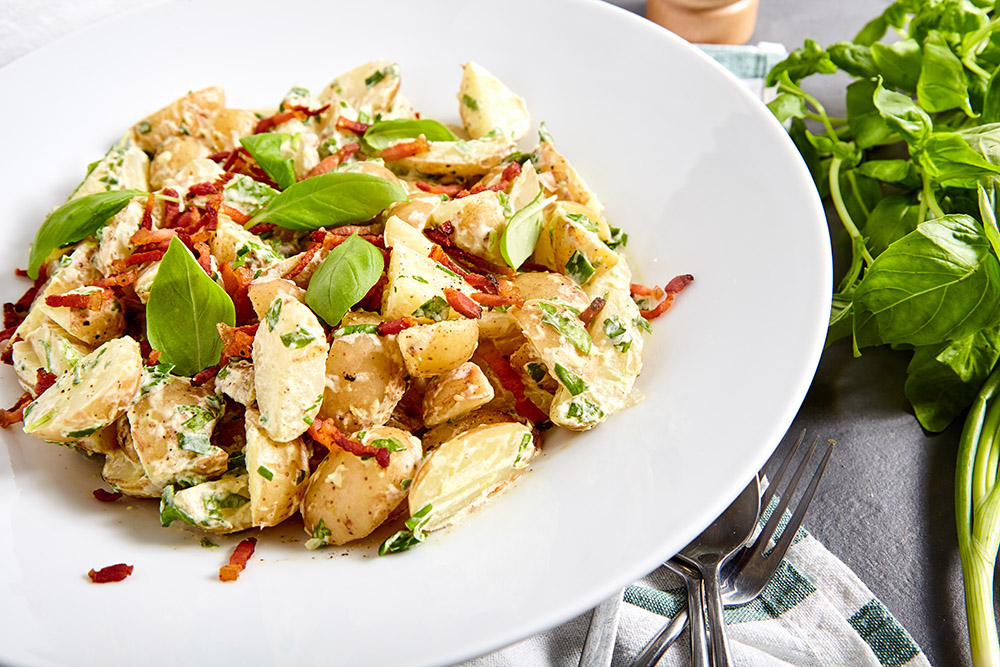
A simple salad to make. Young potatoes with dressing comes out with extraordinary flavor and aroma. Very tender and juicy – melts in the mouth. Crispy, slightly salty bacon makes an interesting addition to this dish. You can replace the yogurt in the dressing with sour cream or mayonnaise.
2. Vegetarian leek and potato soup

A light yet hearty vegetable soup. It tastes sweet and creamy. Good for a diet menu. You don’t need to add milk and cream.

Tasty baked potatoes with cream. And the garlic flavor won’t make this dish stay on your table for long. You can use gratin as a main dish and as a side dish as well.

These potatoes come out crispy, with a toasted crust on the outside. But they stay soft and fluffy on the inside. This dish will become your favorite. It’s simple, quick to make, and as healthy as possible.
5. Fried young potatoes with dill

This dish is very popular in Georgia. A simple and quick recipe to prepare. You can serve it with a spicy sauce. Such potatoes are a great addition to the holiday table and to the family dinner.
6. French fries with egg white in the oven

The value of this dish is that you can cook it without adding oil. To get a crispy crust, use egg white. It turns out a completely healthy and delicious dish. Not only children, but adults will appreciate it.
7. Roasted potatoes, carrots, parsnips and brussels sprouts

Baked vegetables in the oven – what can be healthier, tastier and more nutritious. Such a vegetable assortment is a whole plate of vitamins. Serve as a side dish to meat or fish dishes. Or as a separate dish for a dietary menu.
8. Pilot salad

Potatoes in this dish are complemented by the taste of other vegetable ingredients. Salad with juicy and tender vegetables. It turns out nutritious and beautiful in appearance.

If you really like potatoes – this dish will be your favorite in the variety of potato cooking. Thanks to cottage cheese and flour, the dumplings turn out tender, with a potato flavor. A very hearty and nutritious dish. It looks like lazy dumplings. You can freeze raw potato casseroles.
10. Potato casserole with sausage

An interesting idea for a tasty and quick dinner. The recipe is very simple. The casserole is delicious, beautiful and easy to make. It looks like a pizza.
11. “Boulangerie” – French-style potatoes

An easy dish to prepare. Tastes incredible with potatoes. You can add grated cheese or chopped greens. Looks beautiful and festive.
12. Australian-style potatoes with sour cream sauce

A vegetarian dish, suitable for a dietary menu. The sour cream sauce complements the delicate taste of the potatoes. Be sure to add some herbs and spices to enhance the flavor of this dish.


